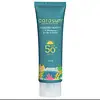What's inside
What's inside
 Key Ingredients
Key Ingredients

 Benefits
Benefits

 Concerns
Concerns

 Ingredients Side-by-side
Ingredients Side-by-side

Water
Skin ConditioningButylene Glycol
HumectantButyl Methoxydibenzoylmethane
UV AbsorberEthylhexyl Methoxycinnamate
UV AbsorberCetearyl Alcohol
EmollientCetyl Alcohol
EmollientIsohexadecane
EmollientPolymethyl Methacrylate
Octocrylene
UV AbsorberPolyacrylamide
Phenoxyethanol
PreservativePolyglyceryl-4 Caprate
EmulsifyingAmmonium Polyacryloyldimethyl Taurate
Emulsion StabilisingLaureth-7
EmulsifyingOryza Sativa Extract
AbsorbentTrehalose
HumectantTrimethoxybenzylidene Pentanedione
AntioxidantC13-14 Isoparaffin
EmollientKaolin
AbrasivePropanediol
SolventLecithin
EmollientEthylhexylglycerin
Skin ConditioningPropylene Glycol
HumectantDMDM Hydantoin
PreservativeArtemisia Capillaris Flower Extract
Skin ConditioningWater, Butylene Glycol, Butyl Methoxydibenzoylmethane, Ethylhexyl Methoxycinnamate, Cetearyl Alcohol, Cetyl Alcohol, Isohexadecane, Polymethyl Methacrylate, Octocrylene, Polyacrylamide, Phenoxyethanol, Polyglyceryl-4 Caprate, Ammonium Polyacryloyldimethyl Taurate, Laureth-7, Oryza Sativa Extract, Trehalose, Trimethoxybenzylidene Pentanedione, C13-14 Isoparaffin, Kaolin, Propanediol, Lecithin, Ethylhexylglycerin, Propylene Glycol, DMDM Hydantoin, Artemisia Capillaris Flower Extract
Water
Skin ConditioningEthylhexyl Methoxycinnamate
UV AbsorberButylene Glycol
HumectantTitanium Dioxide
Cosmetic ColorantMethylene Bis-Benzotriazolyl Tetramethylbutylphenol
UV FilterGlyceryl Stearate
EmollientCetearyl Alcohol
EmollientDimethicone
EmollientIsopropyl Palmitate
EmollientParaffinum Liquidum
EmollientPhenoxyethanol
PreservativePEG-100 Stearate
Carbomer
Emulsion StabilisingDecyl Glucoside
CleansingChlorphenesin
AntimicrobialHydrated Silica
AbrasivePEG-40 Castor Oil
EmulsifyingPotassium Hydroxide
BufferingGlycerin
HumectantAluminum Hydroxide
EmollientSodium Cetearyl Sulfate
CleansingMethicone
EmollientXanthan Gum
EmulsifyingTetrasodium EDTA
Propylene Glycol
HumectantTocopheryl Acetate
AntioxidantAloe Barbadensis Leaf Juice
Skin ConditioningMaltodextrin
AbsorbentPotassium Phosphate
BufferingArgania Spinosa Kernel Oil
EmollientCamellia Oleifera Seed Oil
Skin ConditioningCitrus Sinensis Peel Oil Expressed
PerfumingBHA
AntioxidantPotassium Sorbate
PreservativeSodium Benzoate
MaskingCitric Acid
BufferingWater, Ethylhexyl Methoxycinnamate, Butylene Glycol, Titanium Dioxide, Methylene Bis-Benzotriazolyl Tetramethylbutylphenol, Glyceryl Stearate, Cetearyl Alcohol, Dimethicone, Isopropyl Palmitate, Paraffinum Liquidum, Phenoxyethanol, PEG-100 Stearate, Carbomer, Decyl Glucoside, Chlorphenesin, Hydrated Silica, PEG-40 Castor Oil, Potassium Hydroxide, Glycerin, Aluminum Hydroxide, Sodium Cetearyl Sulfate, Methicone, Xanthan Gum, Tetrasodium EDTA, Propylene Glycol, Tocopheryl Acetate, Aloe Barbadensis Leaf Juice, Maltodextrin, Potassium Phosphate, Argania Spinosa Kernel Oil, Camellia Oleifera Seed Oil, Citrus Sinensis Peel Oil Expressed, BHA, Potassium Sorbate, Sodium Benzoate, Citric Acid
Ingredients Explained
These ingredients are found in both products.
Ingredients higher up in an ingredient list are typically present in a larger amount.
Butylene Glycol (or BG) is used within cosmetic products for a few different reasons:
Overall, Butylene Glycol is a safe and well-rounded ingredient that works well with other ingredients.
Though this ingredient works well with most skin types, some people with sensitive skin may experience a reaction such as allergic rashes, closed comedones, or itchiness.
Learn more about Butylene GlycolCetearyl alcohol is a mixture of two fatty alcohols: cetyl alcohol and stearyl alcohol. It is mainly used as an emulsifier. Emulsifiers help prevent the separation of oils and products. Due to its composition, it can also be used to thicken a product or help create foam.
Cetearyl alcohol is an emollient. Emollients help soothe and hydrate the skin by trapping moisture.
Studies show Cetearyl alcohol is non-toxic and non-irritating. The FDA allows products labeled "alcohol-free" to have fatty alcohols.
This ingredient is usually derived from plant oils such as palm, vegetable, or coconut oils. There is debate on whether this ingredient will cause acne.
Due to the fatty acid base, this ingredient may not be Malassezia folliculitis safe.
Learn more about Cetearyl AlcoholEthylhexyl Methoxycinnamate is an organic compound that provides UVB protection. It often goes by the more common name of octinoxate. It is created from methoxycinnamic acid and 2-ethylhexanol.
Ethylhexyl Methoxycinnamate absorbs UVB rays with wavelengths between 280-320 nm. UV absorbers protect your skin by using chemical reactions to convert UV rays into heat and energy.
UVB (290-320 nm) rays emit more energy than UVA rays. They are capable of damaging DNA, causing sunburns and are thought to be linked to skin cancer.
The state of Hawaii has banned sunscreens containing octinoxate due to its potential impact on coral reefs. More research is needed to bridge gaps in this research. The European Union allows higher levels of octinoxate in sunscreens than the US and Australia.
Ethylhexyl Methoxycinnamate is oil soluble. It is not stable and may lose efficacy when exposed to sunlight.
Learn more about Ethylhexyl MethoxycinnamatePhenoxyethanol is a preservative that has germicide, antimicrobial, and aromatic properties. Studies show that phenoxyethanol can prevent microbial growth. By itself, it has a scent that is similar to that of a rose.
It's often used in formulations along with Caprylyl Glycol to preserve the shelf life of products.
Propylene Glycol is an odorless, colorless liquid. As a humectant, it helps skin retain moisture. It also aids in delivering active ingredients.
Another role of this ingredient is preventing a product from melting or freezing. Propylene glycol also adds antimicrobrial properties to a product, elongating product lifespan.
This ingredient is considered an organic alcohol and commonly added into both cosmetics and foods.
Those with sensitive skin or conditions may develop a rash when using this ingredient.
Learn more about Propylene GlycolWater. It's the most common cosmetic ingredient of all. You'll usually see it at the top of ingredient lists, meaning that it makes up the largest part of the product.
So why is it so popular? Water most often acts as a solvent - this means that it helps dissolve other ingredients into the formulation.
You'll also recognize water as that liquid we all need to stay alive. If you see this, drink a glass of water. Stay hydrated!
Learn more about Water